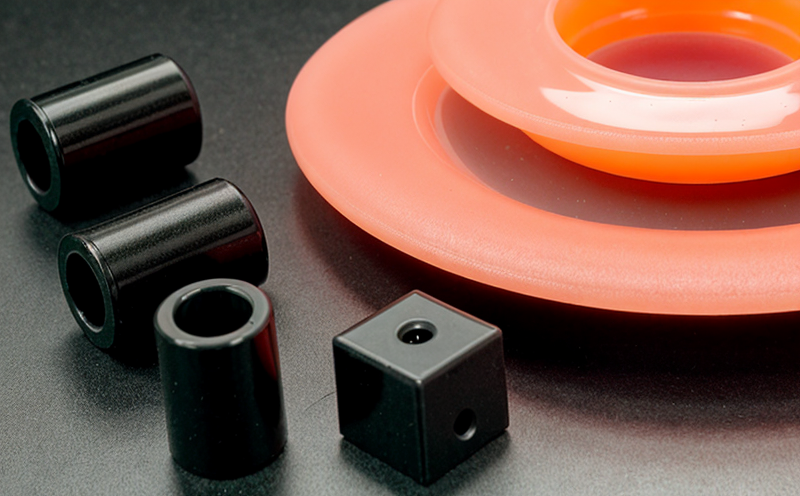DIN EN ISO 604 Compression Testing of Plastic Sports Equipment
The DIN EN ISO 604 compression testing standard is a critical tool in ensuring that plastic sports equipment meets stringent quality and safety standards. This test evaluates the compressive strength and deformation behavior of various plastic materials under specified loading conditions.
Plastic sports equipment, such as paddles, rafts, and shoes, undergoes significant stress during use. Understanding how these materials perform under compression helps manufacturers design safer and more durable products. The test procedure outlined in DIN EN ISO 604 provides a standardized approach to assessing the mechanical properties of plastic components.
The testing process involves compressing a specimen between two flat platens at controlled rates until it reaches its peak load or specified deformation point. The equipment used for this test includes hydraulic presses with adjustable loads and displacement sensors that measure both force and deflection during compression. This data is then analyzed to determine the modulus of elasticity, yield strength, ultimate tensile strength, and other relevant mechanical properties.
Compliance with DIN EN ISO 604 ensures that manufacturers adhere to international standards, which can enhance product reputation and marketability. It also helps in identifying potential weaknesses early on during the design phase, allowing for necessary adjustments before mass production begins.
The test is particularly important for polyurethane foam and other plastic materials used in sports equipment due to their unique properties that affect performance and safety. For instance, high-density foams provide cushioning but must also withstand impacts without deforming excessively. By adhering to this testing protocol, manufacturers can ensure consistent quality across different batches of products.
Understanding the specific requirements for DIN EN ISO 604 is essential for those involved in R&D, compliance, and procurement within the sports & leisure plastics sector. Proper execution of these tests not only guarantees product safety but also contributes to sustainable manufacturing practices by optimizing material usage and reducing waste generation.
Why It Matters
The importance of DIN EN ISO 604 compression testing cannot be overstated, especially in the context of sports & leisure plastics. Compliance with this standard ensures that all plastic components used in sports equipment are reliable and safe for end-users. Non-compliance can lead to product recalls, legal issues, and damage to brand reputation.
Moreover, meeting these standards demonstrates a commitment to quality and safety, which is crucial for maintaining consumer trust and satisfaction. In today’s competitive market, brands that prioritize testing and quality assurance are more likely to gain customer loyalty and long-term success.
The test results provide valuable insights into the mechanical behavior of plastic materials under compression, helping manufacturers make informed decisions about material selection and design improvements. This information can be used to enhance product performance while minimizing costs associated with failed prototypes or subpar materials.
Why Choose This Test
- Ensures compliance with international standards.
- Provides accurate measurement of compressive strength and deformation behavior.
- Helps identify potential weaknesses early in the design process.
- Improves product reliability and safety.
- Enhances brand reputation through consistent quality control practices.
- Aids in sustainable manufacturing by optimizing material usage.
Selecting DIN EN ISO 604 compression testing offers numerous benefits beyond mere regulatory compliance. It enables manufacturers to create safer, more durable products that meet high performance expectations set by customers and industry benchmarks.
Quality and Reliability Assurance
The implementation of DIN EN ISO 604 compression testing plays a pivotal role in ensuring the quality and reliability of plastic sports equipment. This test evaluates how different plastic materials respond to compressive forces, which is crucial given their diverse applications ranging from protective gear like helmets to recreational items such as rafts.
By subjecting samples to controlled compressive loads, manufacturers can assess whether a particular material will hold up under real-world conditions without compromising its integrity. For instance, in the case of sports shoes, this test helps determine if the sole composition can withstand repeated impact forces during running or jumping activities.
The detailed analysis provided by DIN EN ISO 604 enables engineers to fine-tune their designs for optimal performance and longevity. They can explore various combinations of plastic types and additives to achieve desired properties such as flexibility, resilience, and weight reduction without sacrificing safety standards.
Furthermore, adherence to this testing procedure helps companies maintain consistent quality across all production batches by establishing clear benchmarks against which every new batch must be measured. This consistency is vital in maintaining brand integrity and consumer confidence over time.





